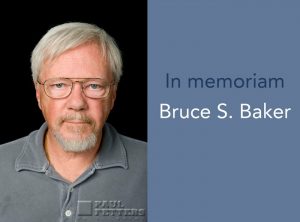 Bruce Stewart Baker—the geneticist whose work uncovered molecular mechanisms of Drosophila sex determination and dosage compensation—died unexpectedly on July 1, 2018. He was 72.
Bruce Stewart Baker—the geneticist whose work uncovered molecular mechanisms of Drosophila sex determination and dosage compensation—died unexpectedly on July 1, 2018. He was 72.
Bruce Baker was born on Dec 20, 1945 to William K. (Bill) Baker—also a renowned Drosophila geneticist —and Margaret I. Stewart in Swananoa, NC, the site of the closest army hospital to where his father was stationed during WWII. Bill and his wife hosted what turned out to be the inaugural Annual Drosophila Research Conference (ADRC) in their home in 1958—with a total of four Drosophila biologists sharing their findings with each other and with a small group of geneticists studying other organisms. The ADRC currently includes over 1500 participants.
Bruce attended high school in Chicago, but left before finishing because he was accepted by Reed College in Portland, Oregon, one of the few places in the country that did not require a high school diploma if one’s SAT scores were high enough. After graduating from Reed in 1966—where he apparently spent quite a lot of time playing poker—Bruce went to the University of Washington where he did his graduate work with Larry Sandler, generating and characterizing X-linked meiotic mutations and the meiotic mutant pal. Bruce received his PhD in 1971 and spent another year doing research in the Sandler Lab before moving to Madison, Wisconsin to do two years of postdoctoral training with James F. Crow. Bruce then spent two years as an Assistant Professor in the Zoology Department at the University of North Carolina, Chapel Hill, before moving to the Biology Department at the University of California, San Diego (UCSD). At UCSD, Bruce rose through the ranks of Assistant, Associate, and Full Professor, sharing his faculty position with his partner at the time, Adelaide T.C. Carpenter. In 1986, Bruce took a position as a Professor in the Biology Department at Stanford University, where he remained for the next 22 years. In 2008, he moved to the Janelia Research Campus of the Howard Hughes Medical Institute, from which he retired in 2016.
Bruce received many accolades throughout his illustrious career. He received the 1991 Genetics Society of America Medal. He shared the National Academy of Sciences Award in Molecular Biology with Professor Thomas Cline in 1992 for their creative use of genetics and molecular biology to uncover how sex is determined in Drosophila. Their work demonstrated that assessing the number of X chromosomes (relative to autosomes) can initiate an RNA splicing cascade that controls all aspects of somatic sexual dimorphism, from external morphologies to sex-specific mating behaviors. Bruce was elected to the National Academy of Sciences in 1993. He was vice-president and then president of the Genetics Society of America in 1993 and 1994. From 2001 until his death, Bruce was the Dr. Morris Herzstein Professor (and then, Professor Emeritus) of Biological Sciences at Stanford.
In his career, Bruce published over 150 papers, most focused on the cellular and genetic mechanisms of how sex—and dosage compensation—is achieved in Drosophila. It was at UCSD that Bruce began his pioneering work uncovering the molecular mechanisms of Drosophila sex determination and dosage compensation. In a seminal paper published in 1980 “Sex and the single cell. I. On the action of major loci affecting sex determination in Drosophila melanogaster”, Bruce first described the phenotypes associated with mutants in each of the major loci affecting sex determination [alone, in combination, and in mosaic clones], revealing that sex in flies is determined at the level of individual cells (i.e. is cell autonomous) and that the genes required for achieving normal sexual morphologies continue to be required in adults to regulate sex-specific courtship behaviors. In the decade that followed, Bruce and postdocs in his lab cloned and molecularly characterized many of the major players regulating sex determination: transformer (tra), transformer-2 (tra-2) and doublesex (dsx). The characterization of these genes led to the surprising finding that sex determination in flies is largely controlled at the level of mRNA splicing, culminating in the production of sex-specific forms of the Dsx transcription factor—whose orthologues function in sex determination in all higher animals, including humans. Through the early 1990’s, Bruce and his team continued to molecularly characterize factors controlling Drosophila sex, including Fruitless, a transcription factor that is also regulated by Tra/Tra-2-dependent splicing and plays a major role in male-specific courtship behaviors. During this time, his group also molecularly characterized several regulators of dosage compensation (male-specific lethal genes) that were shown to be components of a large protein-RNA complex that binds to genes on the single X chromosome in males and increases levels of expression of X-linked genes to equal the level generated from the two copies of these genes in females, which are chromosomally XX. In the two decades that followed, Bruce and his collaborators expanded their studies into the evolution of sex determination, the neural circuitry of sex-specific behaviors, and how the sex determination cascade is integrated with input from other developmental hierarchies to control sexually dimorphic development. Their work revealed key downstream targets and uncovered the neuronal wiring underlying the different behaviors of males and females. Bruce also maintained an interest in genes that function in both meiosis and mitosis, publishing a number of papers with his long-term friend and collaborator Maurizio Gatti, from the Sapienza University of Rome. At every stage in his career, Bruce immediately embraced emerging technologies to answer questions about how sexual morphology and behavior are controlled at the molecular and cellular level.
In the early days of his career, Bruce spent nearly all his waking hours in the lab—seven days a week, nearly 364 days a year (he took Christmas off), maintaining his focus with serial cups of coffee shipped in from Seattle and brewed in an Erlenmeyer flask warmed over a Bunsen burner. Maurizio Gatti remembers returning to the lab with Bruce after dinner, where they often had long late-night conversations not only about science but also history, politics, trekking in wild places, human relationships, personal feelings, and life in general—conversations that Maurizio always found interesting and pleasant because Bruce had not only a wide and deep knowledge of the facts, but also a rather peculiar sense of humor. That same sense of humor often helped break up tense situations in the lab, when Bruce would suddenly giggle after giving a long piercing look that made one feel he was reading your mind, remembers a former student. Bruce had enormous respect for the details of science, not only the science in his own lab but also that of his peers; many of his trainees remember spending several weeks of journal club on a single Tom Cline laboratory paper (some remember several weeks on a single figure). It was that attention to detail that led to Bruce’s insightful models for sex determination and dosage compensation that were elegantly simple and explained everyone’s findings.
Bruce loved the outdoors—trekking, skiing, and fishing, even tying his own flies. His rare escapes from the lab involved trekking expeditions in Nepal, the Fairweather Range, and around Denali, Alaska with his early partner Adelaide Carpenter (one August Alaska trip included getting caught in a blizzard, but surviving with only minor frostbite on the tips of some toes). Bruce also enjoyed cooking, with a particular passion for Cajun, Creole, and Thai food. Many of his trainees and collaborators benefitted from the elaborate meals he would produce of each type of cuisine. Something most of his students and colleagues did not appreciate was Bruce’s skill at the computer game “Civilization”; for several of his years at Stanford, Bruce was the top scorer in this game under the pseudonym “King Bruce”. Bruce must have had to find something new to do in the lab late at night after his group grew large enough so that he didn’t feel like he had to work so hard all the time. Bruce was proud of all of his trainees that went on in science, either to labs of their own or to other science-related careers. He was also immensely proud of and devoted to his wife Allison C. Chin, an environmentalist who served in key leadership positions in the Sierra Club, including as President, and who now serves on the governing boards for the Sierra Club Foundation, Women’s Voices for the Earth, and North American Association for Environmental Education (NAAEE)—an organization dedicated to accelerating environmental literacy and civic engagement through education. Their adventures included backpacking on Baffin Island, rafting the Aichilik River in the Arctic National Wildlife Refuge, and exploring the Antarctic Peninsula. To all who knew him, Bruce was a quiet man with unparalleled scientific rigor, who was willing to stand up to authority for what he believed. He was an inspiring teacher, practicing the Socratic method in the classroom and in the laboratory. Indeed, while he continued to carry out his own experiments even through very late stages in his career, Bruce was also delighted to take time at the bench to teach his trainees—for example, showing them how to “read” the giant salivary gland polytene chromosomes, pointing out all the morphological landmarks, such as the “ballet skirt”, the “onion”, the “duck’s head” and the “goose neck”. For the many of us who still love and do science, we carry with us both Bruce’s high scientific standards, his love of hands-on teaching at the bench, and his unparalleled enthusiasm for discovery.
Guest post by Deborah Andrew with the help of many friends and colleagues of Bruce Baker.































